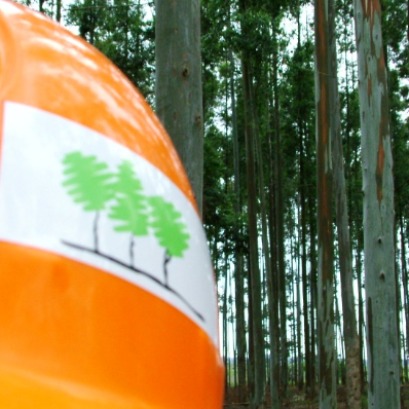
They promote research in pine resins from the NEA
The forestry industry is one of the most important sectors in the economies of Misiones and Corrientes. Thousands of hectares of pine supply the paper, pulp, boards and sawmill industry. Pinus elliottii, one of the species established in the region, in addition to providing wood, is used to produce resin, a non-wood forest product with high demand in the chemical, pharmaceutical and cosmetic industries. In 2\024, resin extraction of approximately 52,6\0\0 tons was achieved from approximately 18,\0\0\0,\0\0\0 trees in production, generating income and jobs with high expansion potential.
Supporting the strengthening of the resin sector, INTA research is advancing studies to enhance resin production in northeastern Argentina. The objective is to diversify the forestry matrix and generate new income alternatives for producers and companies in the region. In this regard, Pablo Peri, coordinator of INTAs National Forestry Program, highlighted that work on resins is incipient and aims for the long term, which is precisely where INTAs research has a lot of value, since it can be sustained over time, which in the case of the forestry sector is key given the duration of the crops. He also pointed out that the research seeks to achieve comprehensive quality with a dual purpose - wood and resin -, which would allow access to a more stable profitability for the producer. Genetics Pine resin is used in the manufacture of adhesives, paints, varnishes, inks, chewing gum, fragrances, pharmaceutical products and even in high-tech applications. The world market is expanding and countries such as Brazil, China and Spain are leading the way in its industrial use. In Argentina it is estimated that there are close to 35 thousand hectares in resin production, concentrated mainly in Corrientes and, to a lesser extent, in Misiones. INTAs contribution focuses on two axes -genetics and management-. In the genetic component, resin productivity and the relative variation of the main resin components in Pinus elliottii families are analyzed, to select high-performance and better quality materials. On the other hand, management practices - age of the tree, planting density, pruning and site conditions - are investigated, which directly influence the quantity and quality of resin. Ector Belaber (INTA Montecarlo) pointed out that, together with the EEA INTA Concordia, trials of progenies of Pinus elliottii families with high resin production were established. In parallel, with the support of INTA Castelar, the chemical composition of the resin of the mother trees of these tests is analyzed. The goal is to identify individuals superior in productivity and resin quality to establish new seed orchards of higher genetic quality than currently available. On the other hand, at INTA Montecarlo the resin production of the F1 INTA-PINDO hybrid pine is evaluated. Unlike Pinus elliottii, here the objective is to select families with low resin production to ensure better quality sawing. Currently, resin production is measured in different families using an indirect method: collecting tubes are installed that, after a period, are weighed to estimate the productivity of each tree and its family\; Measurements are repeated throughout the seasons. With a group of families already classified, sawmilling tests are carried out with the support of the INTA Montecarlo wood quality group. If the correlation between the measurement with tubes in the field and the quality of the boards is significant, a rapid and economical technique will be validated to identify hybrid materials that increase the profitability of sawmills by offering wood with a lower resin content and, consequently, greater commercial value. Added ValueThe research is not limited to the laboratory or experimental tests. The challenge is to bring knowledge to the territory and transform it into concrete opportunities for small and medium producers. The resin represents additional income while the plantations reach the wood harvesting age, diversifying risks and improving profitability. In addition, the installation of processing plants opens the possibility of generating local employment and adding value at origin, strengthening the regional forestry chain. The INTA Forestry Program seeks to consolidate this line of work in coordination with companies, cooperatives and provincial organizations. The next steps include, on the one hand, expanding field trials in different areas of Misiones and Corrientes and, on the other, evaluating resin extraction and processing technologies adapted to a local scale.
IT MAY INTEREST YOU
 Between Rivers | Everything ready for the traditional INTA Concordia and AIANER Forestry Days
Between Rivers | Everything ready for the traditional INTA Concordia and AIANER Forestry Days
The traditional Entre Ríos Forest Days, which this year celebrate their 39th edition, will take place on November 7 from 8 a.m. to 6 p.m. at the INTA Concordia facilities, located at Yuquerí Station and Railway tracks.
 Botanists discover giant trees up to 3,��� years old in Tanzania, unknown until now by science
Botanists discover giant trees up to 3,��� years old in Tanzania, unknown until now by science
Scientists have identified a new species of giant tree, Tessmannia princeps, in the Udzungwa Mountains. This species had never before been recorded by science.
 They present the Elárbol project in the Ecology Cycle
They present the Elárbol project in the Ecology Cycle
The transmedia initiative reflects the importance of Argentine native flora and focuses on the carob tree as an emblem tree. Today, at 6:�� p.m., at the Argentine Library This Thursday, October 3�, at 6 p.m., the Elárbol project is presented in the Ecology Cycle coordinated by Sergio Rinaldi at the Argentine Library.





















